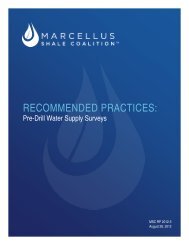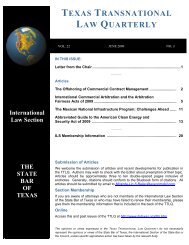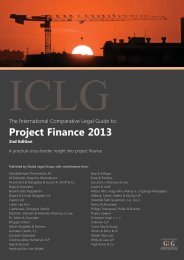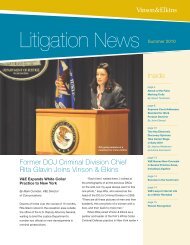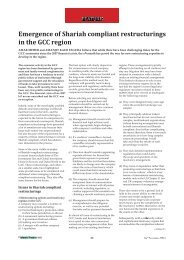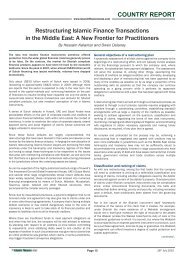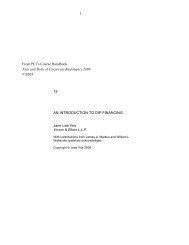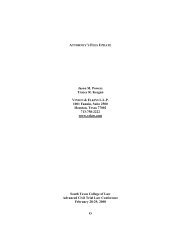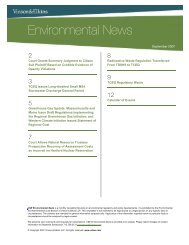Overview of U.S. Export Controls and Sanctions Issues Relating to ...
Overview of U.S. Export Controls and Sanctions Issues Relating to ...
Overview of U.S. Export Controls and Sanctions Issues Relating to ...
Create successful ePaper yourself
Turn your PDF publications into a flip-book with our unique Google optimized e-Paper software.
29 August 2011<br />
V&E China Practice Group<br />
<strong>Overview</strong> <strong>of</strong> U.S. <strong>Export</strong> <strong>Controls</strong> <strong>and</strong> <strong>Sanctions</strong> <strong>Issues</strong><br />
<strong>Relating</strong> <strong>to</strong> the Design, Development <strong>and</strong>/or Production <strong>of</strong><br />
Electric Vehicles in the People’s Republic <strong>of</strong> China<br />
Part I <strong>of</strong> this series focused on various rules governing the investment in electric vehicle projects in the People’s<br />
Republic <strong>of</strong> China, including the equity participation <strong>and</strong> qualification requirements, as well as the rules for<br />
establishing the various PRC entities for conducting business in the PRC’s electric vehicle industry. Part II<br />
focused on the various intellectual property-related issues for conducting business in the PRC. Part III will<br />
discuss how various U.S. export controls-related issues impact investment in the PRC electric vehicle industry<br />
(including design, development <strong>and</strong>/or production <strong>of</strong> electric vehicles).<br />
Table <strong>of</strong> Contents<br />
I. Executive Summary ....................................................................................................................................2<br />
II. U.S. <strong>Export</strong> <strong>Controls</strong> <strong>and</strong> <strong>Sanctions</strong>: Key Concepts ...................................................................................3<br />
1. <strong>Export</strong> <strong>Controls</strong> <strong>of</strong> Commercial <strong>and</strong> “Dual Use” Items <strong>and</strong> Technology Under the EAR...............3<br />
(i) Penalties for Violations <strong>of</strong> the EAR ...................................................................................4<br />
(ii) The Broad Extraterri<strong>to</strong>rial Reach <strong>of</strong> the EAR ....................................................................4<br />
(iii) Special Considerations for <strong>Export</strong>s <strong>to</strong> Foreign Persons Under the EAR..........................5<br />
(iv) <strong>Export</strong> Restrictions Under the EAR...................................................................................5<br />
(v) Items Not “Subject <strong>to</strong> the EAR”.........................................................................................9<br />
2. <strong>Export</strong> <strong>Controls</strong> <strong>of</strong> Military Items <strong>and</strong> Technology Under the ITAR .............................................10<br />
3. Restrictions on Transactions Under the OFAC <strong>Sanctions</strong>...........................................................11<br />
III.<br />
Current Compliance Considerations <strong>Relating</strong> <strong>to</strong> the Design, Development, or Production <strong>of</strong> Electric<br />
Vehicle Production in the PRC..................................................................................................................12<br />
1. Compliance Considerations in Determining <strong>Export</strong> License Requirements ................................12<br />
2. Compliance Considerations in Dealing with a Party Ineligible <strong>to</strong> Receive <strong>Export</strong>s .....................13<br />
3. Compliance Considerations Resulting from OFAC <strong>Sanctions</strong>.....................................................14<br />
IV. Future Compliance Considerations Resulting from Possible <strong>Export</strong> Reform ...........................................14<br />
1
I. Executive Summary<br />
The international <strong>and</strong> competitive nature <strong>of</strong> business in <strong>to</strong>day’s global economy dem<strong>and</strong>s that the export<br />
<strong>of</strong> products <strong>and</strong> technology from the U.S. <strong>to</strong> other parts <strong>of</strong> the world become an integral part <strong>of</strong> most<br />
company business plans. This is certainly true <strong>of</strong> U.S. companies engaged in the design, development,<br />
<strong>and</strong> production <strong>of</strong> electric vehicles (EVs). These companies need innovative technical solutions,<br />
cost-effective production capabilities <strong>and</strong> the ability <strong>to</strong> market <strong>and</strong> sell products worldwide. As a result, it<br />
is essential that U.S. export controls <strong>and</strong> sanctions laws <strong>and</strong> regulations be considered by companies<br />
upfront as part <strong>of</strong> their strategic planning. Noncompliance with these laws <strong>and</strong> regulations can result in<br />
significant civil <strong>and</strong> criminal penalties as well as the interruption <strong>of</strong> commercial business activities with<br />
serious financial repercussions.<br />
This overview identifies the main U.S. export controls regulations <strong>and</strong> sanctions regimes in place <strong>to</strong>day,<br />
with a focus on those areas that likely will be most applicable <strong>to</strong> EV developers <strong>and</strong> manufacturers who<br />
are considering the involvement <strong>of</strong> the People’s Republic <strong>of</strong> China (the “PRC”) as part <strong>of</strong> their business<br />
strategy. 1 The most relevant regulations are the <strong>Export</strong> Administration Regulations (the “EAR”)<br />
administered by the U.S. Department <strong>of</strong> Commerce’s Bureau <strong>of</strong> Industry <strong>and</strong> Security (the “BIS”), as<br />
well as various sanctions regulations administered by the U.S. Department <strong>of</strong> Treasury’s Office <strong>of</strong><br />
Foreign Assets Control (OFAC).<br />
A U.S. company currently will be able <strong>to</strong> work with PRC companies <strong>and</strong> individuals in designing,<br />
developing <strong>and</strong> producing EVs in most cases, assuming it develops an appropriate compliance plan<br />
with the necessary safeguards <strong>to</strong> guard against violations <strong>of</strong> U.S. export <strong>and</strong> sanctions laws. Presently,<br />
the EAR, which covers the export <strong>and</strong> re-export <strong>of</strong> most non-military items, does not impose a general<br />
license requirement for the export <strong>to</strong> the PRC <strong>of</strong> a completed EV or <strong>of</strong> some <strong>of</strong> its major components<br />
(i.e., charger, battery, mo<strong>to</strong>r, etc.) or <strong>of</strong> related technology. To the extent a license requirement would be<br />
applicable, it is more likely <strong>to</strong> involve lower level assemblies <strong>and</strong> individual parts <strong>and</strong> components. Items<br />
as varied as electronics, computer equipment, encryption s<strong>of</strong>tware, <strong>and</strong> even certain valves <strong>and</strong><br />
bearings, possibly could require a license for export <strong>to</strong> the PRC. In some cases, specialized<br />
manufacturing equipment or certain raw materials could be subject <strong>to</strong> an export license requirement.<br />
These items are intended <strong>to</strong> be illustrative only. Specific license requirements applicable <strong>to</strong> particular<br />
equipment or technology would have <strong>to</strong> be reviewed on a case-by-case basis.<br />
Therefore, it is essential that U.S. exporters identify the export controls that are applicable <strong>to</strong> all <strong>of</strong> their<br />
equipment <strong>and</strong> technology, down <strong>to</strong> the part <strong>and</strong> component level. This is particularly important for<br />
exports involving the PRC, as China is considered <strong>to</strong> be a sensitive destination for export purposes <strong>and</strong><br />
the U.S. has imposed a “China Rule,” which imposes special restrictions on items that would not<br />
otherwise require a license, except that the U.S. believes these items could contribute <strong>to</strong> the PRC’s<br />
military capability.<br />
Aside from any export license requirements that might be applicable, another compliance risk that must<br />
be considered is that certain PRC entities have been sanctioned by the U.S. government for national<br />
security or foreign policy reasons <strong>and</strong> now may be ineligible <strong>to</strong> receive exports <strong>and</strong>/or participate in<br />
transactions with U.S. persons. As a result, it is critical that U.S. companies thoroughly screen all parties<br />
<strong>to</strong> a potential transaction <strong>to</strong> ensure they are not violating any U.S. export or sanctions law or regulation<br />
by working with a particular PRC entity or person.<br />
1<br />
U.S. export control laws distinguish between the PRC — mainl<strong>and</strong> China — <strong>and</strong> Hong Kong <strong>and</strong> Taiwan. As such, conclusions <strong>and</strong><br />
assertions relating <strong>to</strong> the PRC discussed herein apply <strong>to</strong> mainl<strong>and</strong> China but do not necessarily apply <strong>to</strong> Hong Kong or Taiwan.<br />
2
Furthermore, while it is unlikely that a U.S. company involved in the development <strong>and</strong> production <strong>of</strong> EVs<br />
would want <strong>to</strong> do business with such a sanctioned entity, a more likely possibility is that a PRC entity<br />
could re-export U.S. origin EV equipment or technology <strong>to</strong> sanctioned countries or individuals (for<br />
example <strong>to</strong> broaden their market share by selling EVs in Iran). The PRC routinely does business with<br />
countries (such as Cuba, Iran, <strong>and</strong> North Korea, etc.) <strong>and</strong> certain individuals (including those<br />
designated as Specially Designated Nationals, or “SDNs,” by OFAC) with whom U.S. persons are<br />
prohibited from doing business. As such, safeguards need <strong>to</strong> be built in<strong>to</strong> any contracts with PRC<br />
companies <strong>to</strong> ensure they agree <strong>to</strong> abide with applicable U.S. export <strong>and</strong> sanctions restrictions. For<br />
example, many compliance-minded companies include a “proceeds” provision in their contracts, <strong>to</strong><br />
ensure that any payments they make are not ultimately used for a purpose that would violate U.S. law.<br />
Although EVs normally should be subject <strong>to</strong> the export controls <strong>of</strong> the EAR, in the event that an EV was<br />
designed or modified for military use (either U.S. military or foreign military), under current U.S. controls,<br />
the resulting vehicle likely would end up being controlled by the more restrictive export controls <strong>of</strong> the<br />
International Traffic in Arms Regulations (the “ITAR”). Under the ITAR, the PRC is a “proscribed<br />
destination,” meaning that PRC companies <strong>and</strong> nationals could not be involved in the development <strong>of</strong><br />
such vehicles <strong>and</strong> the vehicles could not be sold in the PRC. As such, U.S. EV companies should<br />
exercise caution when entering in<strong>to</strong> any arrangements with U.S. or foreign militaries which could<br />
possibly subject their end product <strong>to</strong> ITAR controls.<br />
Notwithst<strong>and</strong>ing these concerns, based on the current state <strong>of</strong> U.S. export <strong>and</strong> sanctions laws <strong>and</strong><br />
regulations, U.S. companies should be able <strong>to</strong> engage PRC companies <strong>and</strong> individuals on EV design,<br />
development, <strong>and</strong> production issues as long as they implement appropriate compliance plans <strong>to</strong><br />
mitigate areas <strong>of</strong> potential risk.<br />
II.<br />
U.S. <strong>Export</strong> <strong>Controls</strong> <strong>and</strong> <strong>Sanctions</strong>: Key Concepts<br />
U.S. export control laws <strong>and</strong> regulations broadly control exports <strong>to</strong> foreign persons. In addition, OFAC<br />
also broadly controls a range <strong>of</strong> transactions with embargoed countries <strong>and</strong> designated individuals <strong>and</strong><br />
entities.<br />
An “<strong>Export</strong>” for the purpose <strong>of</strong> U.S. export laws <strong>and</strong> regulations generally includes any shipment <strong>of</strong><br />
products or technology outside <strong>of</strong> the U.S. Any disclosure <strong>of</strong> technology <strong>to</strong> foreign persons (located<br />
either inside or outside the U.S.) is also considered an export. Technology can include tangible items <strong>of</strong><br />
any kind, such as drawings, specifications, <strong>and</strong> email correspondence. Technology can also be<br />
disclosed through less tangible means, such as through teleconferences, plant <strong>to</strong>urs, or other methods.<br />
Delivery <strong>of</strong> products or technology <strong>to</strong> a foreign embassy located in the U.S. is an export.<br />
A “Foreign Person” for the purpose <strong>of</strong> U.S. export laws <strong>and</strong> regulations, generally includes any natural<br />
person who is not a U.S. citizen, or a lawful permanent U.S. resident (or a member <strong>of</strong> other very limited<br />
protected classes). A foreign person also includes entities, such as foreign corporations, partnerships,<br />
trusts, societies, that are not incorporated or organized <strong>to</strong> do business in the U.S.<br />
1. <strong>Export</strong> <strong>Controls</strong> <strong>of</strong> Commercial <strong>and</strong> “Dual Use” Items <strong>and</strong> Technology Under the EAR<br />
The Department <strong>of</strong> Commerce, through the BIS, is responsible for administration <strong>of</strong> the EAR, 15<br />
C.F.R. Part 730 et seq., which governs the export <strong>and</strong> re-export <strong>of</strong> commercial <strong>and</strong> “dual use”<br />
(items with both military <strong>and</strong> commercial applications) commodities <strong>and</strong> related technology. As<br />
a practical matter, the scope <strong>of</strong> the EAR is enormous, controlling items ranging from the most<br />
benign everyday products, such as pens <strong>and</strong> pencils, <strong>to</strong> highly sophisticated <strong>and</strong> sensitive<br />
items, such as machine <strong>to</strong>ols, encryption products, sensors, lasers, computers, <strong>and</strong> propulsion<br />
3
equipment, as well as related s<strong>of</strong>tware <strong>and</strong> technology. The export controls prescribed by the<br />
EAR will be applicable <strong>to</strong> the development <strong>and</strong> production <strong>of</strong> EVs, as a general rule.<br />
(i)<br />
Penalties for Violations <strong>of</strong> the EAR<br />
The penalties for violations <strong>of</strong> the EAR can be both civil <strong>and</strong>/or criminal. Criminal<br />
penalties (for willful violations) can reach as high as $1 million <strong>and</strong> include up <strong>to</strong> 20<br />
years imprisonment. Civil penalties can reach $250,000 per violation or twice the<br />
amount <strong>of</strong> the transaction that is the basis <strong>of</strong> the violation. Penalties may also include a<br />
denial <strong>of</strong> export privileges or suspension/debarment from government contracting,<br />
which can <strong>of</strong>ten prove <strong>to</strong> be more damaging <strong>to</strong> a company’s business <strong>and</strong> reputation<br />
than a monetary fine.<br />
According <strong>to</strong> published guidelines, the BIS will consider both aggravating <strong>and</strong> mitigating<br />
fac<strong>to</strong>rs in each case in deciding the particular penalty. Voluntary disclosure serves as a<br />
primary mitigating fac<strong>to</strong>r in deciding penalties. The BIS aggressively enforces<br />
noncompliance with the EAR, <strong>of</strong>ten with assistance from other U.S. government<br />
agencies. In recent years, significant enforcement action has been taken against both<br />
U.S. <strong>and</strong> foreign companies. See, e.g., BUREAU OF INDUSTRY AND SECURITY, U.S. DEP’T<br />
OF COMMERCE, “OTHER RELATED ENFORCEMENT TOPICS,” www.bis.doc.gov/compliancean<br />
denforcment/otheree<strong>to</strong>pics.htm#penalties.<br />
Recently, in March 2011, the BIS fined ArvinMeri<strong>to</strong>r, a Michigan company, $100,000 for<br />
shipping vehicle axles <strong>and</strong> seal assemblies controlled for national security reasons <strong>to</strong><br />
China <strong>and</strong> some other countries, notwithst<strong>and</strong>ing the fact that ArvinMeri<strong>to</strong>r had<br />
voluntarily disclosed the violation, which significantly mitigated the penalties that<br />
otherwise might have been imposed. BIS enforcement actions relating <strong>to</strong> the PRC are<br />
not unusual. For example, in a September 2010 bulletin, entitled “Don’t Let This<br />
Happen <strong>to</strong> You,” which highlighted recent BIS export enforcement actions, <strong>of</strong> the 103<br />
cases summarized in the bulletin, approximately 23 percent (or 24 cases) involved<br />
exports <strong>to</strong> China. Id. at www.bis.doc.gov/compliance<strong>and</strong>enforcement/dontletthishappen<br />
<strong>to</strong>you_2010.pdf.<br />
(ii)<br />
The Broad Extraterri<strong>to</strong>rial Reach <strong>of</strong> the EAR<br />
With limited exceptions, discussed below, all items in the U.S. are subject <strong>to</strong> the EAR,<br />
as are most items <strong>of</strong> U.S. origin, wherever they are located. This includes U.S. origin<br />
parts, components <strong>and</strong> materials integrated in<strong>to</strong> foreign made products, commingled<br />
U.S. origin s<strong>of</strong>tware, commingled U.S. origin technology <strong>and</strong> in some cases foreign<br />
products developed from U.S. technology. The only exception <strong>to</strong> this broad<br />
extraterri<strong>to</strong>rial reach is that the U.S. relinquishes control <strong>of</strong> EAR-controlled items <strong>and</strong><br />
technology (for most, but not all items), if they are considered “de minimis” <strong>to</strong> the<br />
foreign product. To be considered de minimis, U.S. content must comprise no more<br />
than 25 percent <strong>of</strong> the <strong>to</strong>tal value <strong>of</strong> the item, except if the item will be re-exported <strong>to</strong> an<br />
embargoed country (i.e., Cuba, Iran, North Korea, Sudan or Syria), in which case the<br />
value <strong>of</strong> U.S. content must be 10 percent or less than the <strong>to</strong>tal value <strong>of</strong> the item.<br />
The EAR outlines a complicated formula that must be used <strong>to</strong> correctly determine the<br />
valuation. 15 C.F.R. (hereinafter “EAR”) at § 734.4.<br />
4
(iii)<br />
Special Considerations for <strong>Export</strong>s <strong>to</strong> Foreign Persons Under the EAR<br />
In cases where a foreign person has more than one foreign nationality, under the EAR,<br />
the BIS looks <strong>to</strong> the “last” nationality (unless there are unique circumstances which<br />
would suggest that methodology should not apply). As an example, if a person was<br />
born in the PRC <strong>and</strong> then became either a permanent resident <strong>of</strong> or citizen <strong>of</strong> Canada,<br />
under the EAR the individual would normally be considered a national <strong>of</strong> Canada. 2<br />
An export <strong>to</strong> a foreign person who is located in the U.S. is “deemed” <strong>to</strong> be an export <strong>to</strong><br />
the person’s home country. Accordingly, under the EAR, an export <strong>of</strong> technology<br />
subject <strong>to</strong> the EAR <strong>to</strong> a PRC national employed by a U.S. company or institution <strong>of</strong><br />
higher learning would be deemed <strong>to</strong> be an export back <strong>to</strong> the PRC whether or not the<br />
individual ever would (or realistically could) disclose the information <strong>to</strong> the PRC.<br />
(iv)<br />
<strong>Export</strong> Restrictions Under the EAR<br />
(a)<br />
Restrictions Are Based on Item, End User <strong>and</strong> End Use<br />
Given the enormous scope <strong>of</strong> items controlled by the EAR, it would neither be<br />
realistic nor practical for the BIS <strong>to</strong> require an export license <strong>to</strong> export each <strong>and</strong><br />
every type <strong>of</strong> product, s<strong>of</strong>tware or technology <strong>to</strong> every destination. Rather,<br />
items are restricted for export purposes based on the item, end user <strong>and</strong> end<br />
use. This requires a careful review <strong>of</strong> the EAR <strong>to</strong> determine what particular<br />
controls might apply. Under the Commerce Control List (the “CCL”) <strong>of</strong> the EAR,<br />
found at 15 C.F.R. Part 774, items are grouped under ten broad product<br />
categories (numbered 0-9):<br />
(0) Nuclear materials, facilities <strong>and</strong> equipment [<strong>and</strong> miscellaneous items]<br />
(1) Materials, chemicals <strong>and</strong> <strong>to</strong>xins<br />
(2) Materials processing<br />
(3) Electronics<br />
(4) Computers<br />
(5) Telecommunications <strong>and</strong> Information Security<br />
(6) Sensors <strong>and</strong> lasers<br />
(7) Navigation <strong>and</strong> avionics<br />
(8) Marine<br />
(9) Propulsion systems, space vehicles <strong>and</strong> related equipment<br />
Within each <strong>of</strong> these general categories, items are further broken down in<strong>to</strong><br />
subcategories. For each product category, Subcategory (A) controls<br />
Equipment, Assemblies <strong>and</strong> Components; Subcategory (B) controls Production<br />
2<br />
BUREAU OF INDUSTRY AND SECURITY, U.S. DEP’T OF COMMERCE, “DEEMED EXPORT” FAQS, www.bis.doc.gov/deemedexports/<br />
deemedexportsfaqs.html#11.<br />
5
<strong>and</strong> Test Equipment; Subcategory (C) controls Materials; Subcategory (D)<br />
controls S<strong>of</strong>tware; <strong>and</strong> Subcategory (E) controls Technology.<br />
Within each <strong>of</strong> the ten product categories, individual products, materials,<br />
s<strong>of</strong>tware <strong>and</strong> technology are all controlled by their functionality under specific<br />
<strong>Export</strong> Control Classification Numbers (ECCNs). Items that are not specifically<br />
identified under ECCNs are subject <strong>to</strong> the least restrictive controls <strong>and</strong> have the<br />
default export control classification <strong>of</strong> “EAR99.” If the designation “EAR99”<br />
applies, such exports will require an export license from the BIS only if they are<br />
(1) sent <strong>to</strong> an embargoed country or <strong>to</strong> a person or entity considered ineligible<br />
by the U.S. government <strong>to</strong> receive exports or (2) exported under a<br />
circumstance which would violate a “General Prohibition” <strong>of</strong> the EAR. These<br />
circumstances are described in Section II.1(iv)(c)-(d) below.<br />
It is <strong>of</strong>ten difficult <strong>to</strong> determine whether a particular ECCN applies. In some<br />
cases, it may be necessary <strong>to</strong> make a formal “classification request” <strong>to</strong> the BIS<br />
<strong>to</strong> confirm the control status <strong>of</strong> an item. One challenge in classifying items<br />
under the EAR is that the controls that apply <strong>to</strong> an end item <strong>of</strong>ten do not apply<br />
<strong>to</strong> its individual parts or components. In many cases, an end item may have<br />
more restrictive export controls than its individual minor parts <strong>and</strong> components<br />
<strong>of</strong> the item, although in some cases the opposite is true, particularly when<br />
dealing with unique embedded electronics, sensors or encryption items. For<br />
that reason, it is sometimes the case that an end item can be shipped <strong>to</strong> a final<br />
destination without a license, although a spare part or component shipped<br />
separately at a later date could require a license.<br />
Once the correct ECCN for the particular item <strong>to</strong> be exported is identified, the<br />
ECCN will list the applicable “reasons for control” for the item. Possible<br />
“reasons for control” under the EAR are restrictions based on one or more<br />
national security <strong>and</strong> foreign policy concerns. The most common reasons for<br />
control include: Chemical & Biological Weapons [CB], Nuclear Non-Proliferation<br />
[NP], National Security [NS], Missile Technology [MT], Regional Stability [RS],<br />
Firearms Convention [FC], Crime Control [CC], Encryption Item [EI] <strong>and</strong><br />
Anti-Terrorism [AT] concerns. See EAR, at § 738.2(d)(2)(i)(A)(2010).<br />
Once the reasons for control for a particular ECCN have been identified, the<br />
Commerce Country Chart (Supplement No. 1 <strong>to</strong> Part 738) must then be<br />
consulted <strong>to</strong> identify the particular controls that apply for exports <strong>to</strong> a particular<br />
country. For example, a particular item or technology that is controlled for CC<br />
(Crime Control) reasons generally would require an export license for shipment<br />
<strong>to</strong> the PRC, while the same item would not require a license if it were shipped<br />
<strong>to</strong> the United Kingdom. In the case <strong>of</strong> the PRC, all <strong>of</strong> the “reasons for control”<br />
identified above generally apply, except for AT controls. This means that<br />
exports <strong>of</strong> many items will require a license for the PRC, unless a license<br />
exception applies.<br />
The EAR contains at least 17 major license exceptions under which the<br />
exporter may not need a license <strong>to</strong> export even if the analysis set forth above<br />
indicates that an item requires a license for shipment <strong>to</strong> a particular destination.<br />
All license exceptions are subject <strong>to</strong> strict conditions, which means that<br />
exporters must read the “fine print” in the EAR <strong>to</strong> determine whether a license<br />
6
exception does, in fact, apply <strong>to</strong> a particular transaction. Some license<br />
exceptions are value based, meaning that they can only be used for limited<br />
quantities <strong>of</strong> certain items. Other license exceptions are ECCN based, meaning<br />
they are available for the export <strong>of</strong> some items controlled under some ECCNs<br />
<strong>and</strong> not others. Finally, certain license exceptions are destination based,<br />
meaning that they are available depending on the country <strong>of</strong> intended export<br />
<strong>and</strong>/or recipient. Although an exception may indeed be available for a particular<br />
export <strong>to</strong> the PRC, it should be noted that in many cases, a license will be<br />
required, because the PRC is considered <strong>to</strong> be a sensitive destination.<br />
(b)<br />
<strong>Export</strong>s <strong>to</strong> the PRC Subject <strong>to</strong> Additional Restrictions Under “China Rule”<br />
With respect <strong>to</strong> items controlled for NS (National Security) reasons, the BIS<br />
maintains a general policy <strong>of</strong> approval for exports <strong>to</strong> the PRC for civil end-uses<br />
<strong>and</strong> a presumption <strong>of</strong> denial for license applications <strong>to</strong> export, re-export, or<br />
transfer items <strong>to</strong> the PRC that would make “a direct <strong>and</strong> significant contribution<br />
<strong>to</strong> the PRC’s military capabilities.” See EAR, at § 742.4(b)(7). This policy was<br />
established under EAR provisions implemented in 2007 that specifically<br />
addressed exports <strong>to</strong> the PRC (i.e., the “China Rule”). 72 Fed. Reg. 33,646<br />
(June 19, 2007). The EAR does not define when an export is considered <strong>to</strong><br />
make such a “direct <strong>and</strong> significant contribution,” though the BIS comments in<br />
publishing the China Rule indicates that this is a narrower st<strong>and</strong>ard than the<br />
“material contribution” st<strong>and</strong>ard applicable <strong>to</strong> exports <strong>of</strong> items destined for<br />
military end-use (see below). Id. at 33,647.<br />
A more prohibitive license review policy applies <strong>to</strong> exports <strong>of</strong> items <strong>to</strong> the PRC<br />
for a “military end-use.” For purposes <strong>of</strong> this policy, “military end-use” includes<br />
incorporation in<strong>to</strong>, use in, development <strong>of</strong>, or production <strong>of</strong> 1) military items<br />
described in the U.S. Munitions List <strong>of</strong> the ITAR; 2) military items described in<br />
the Munitions List <strong>of</strong> the Wassenaar Arrangement; <strong>and</strong> 3) any item listed under<br />
an ECCN ending in A018. EAR, at § 744.21(f).<br />
Applications <strong>to</strong> export or otherwise transfer items for a “military end-use” in the<br />
PRC are reviewed on a case-by-case basis, <strong>to</strong> determine whether transfer<br />
“would make a material contribution <strong>to</strong> the military capabilities <strong>of</strong> the PRC <strong>and</strong><br />
would result in advancing the country’s military activities contrary <strong>to</strong> the national<br />
security interests <strong>of</strong> the United States.” Id. If the BIS determines that such a<br />
contribution will result, the license is denied. The China Rule also established a<br />
Validated End-User program for the PRC which is most useful <strong>to</strong> companies<br />
seeking repeated, large volume exports <strong>to</strong> one particular cus<strong>to</strong>mer. Id. at<br />
§ 748.15. It also imposed a PRC End-User Statement requirement for license<br />
applications for exports <strong>of</strong> products (as opposed <strong>to</strong> license applications for<br />
s<strong>of</strong>tware or technology exports). Id. at § 748.9(a)(6)-(7).<br />
(c)<br />
EAR-Controlled <strong>Export</strong>s Subject <strong>to</strong> Catch-All “General Prohibitions”<br />
In addition <strong>to</strong> controlling exports <strong>to</strong> foreign persons, the EAR also prohibits<br />
certain activities that can go beyond the scope <strong>of</strong> a mere export, <strong>and</strong> may<br />
prohibit engaging in actions prohibited by a BIS denial order; engaging in<br />
certain proliferation activities (i.e., nuclear, missile, chemical/biological) or<br />
proceeding with “knowledge” that a violation has occurred or is about <strong>to</strong> occur.<br />
7
Under the EAR, “knowledge” includes not only positive knowledge that a<br />
circumstance exists or is substantially certain <strong>to</strong> occur, but also an awareness<br />
<strong>of</strong> a high probability <strong>of</strong> its existence or future occurrence. Awareness may be<br />
inferred from a conscious disregard or willful avoidance <strong>of</strong> facts. In other words,<br />
exporters may not “self blind” when considering a potential export transaction.<br />
In order <strong>to</strong> help identify situations where a violation <strong>of</strong> a General Prohibition<br />
may occur, the EAR includes a list <strong>of</strong> warning signals, known as “Red Flags.”<br />
See EAR Part 732, Supp. 3. If no red flags reasonably are or should be<br />
apparent, there is no affirmative duty on exporters <strong>to</strong> perform additional due<br />
diligence related <strong>to</strong> the transaction. However, if any red flags are triggered in<br />
relation <strong>to</strong> a particular cus<strong>to</strong>mer or transaction, the exporter has a duty <strong>to</strong><br />
inquire further <strong>and</strong> investigate any suspicious circumstances. Circumstances<br />
that should trigger further investigation include (but are not limited <strong>to</strong>):<br />
(i)<br />
(ii)<br />
(iii)<br />
(iv)<br />
(v)<br />
(vi)<br />
(vii)<br />
(viii)<br />
(ix)<br />
(x)<br />
(xi)<br />
(xii)<br />
Cus<strong>to</strong>mer is reluctant <strong>to</strong> <strong>of</strong>fer information about end use <strong>of</strong> the product;<br />
Product’s capabilities do not fit cus<strong>to</strong>mer’s line <strong>of</strong> business;<br />
Product is incompatible with the technical level <strong>of</strong> receiving country;<br />
Cus<strong>to</strong>mer has little or no business background;<br />
Cus<strong>to</strong>mer is willing <strong>to</strong> pay cash for expensive items when terms <strong>of</strong> sale<br />
call for financing;<br />
Cus<strong>to</strong>mer is unfamiliar with product’s performance characteristics;<br />
Cus<strong>to</strong>mer declines routine installation, training or maintenance<br />
services;<br />
Vague delivery dates <strong>and</strong> delivery <strong>to</strong> out-<strong>of</strong>-the-way destinations;<br />
Freight forwarder is listed as the product’s final destination;<br />
Abnormal shipping route;<br />
Packaging is inconsistent with the stated method <strong>of</strong> shipment or<br />
destination; <strong>and</strong><br />
Cus<strong>to</strong>mer is evasive about whether product is for domestic use, export<br />
or re-export.<br />
(d)<br />
Restrictions on <strong>Export</strong>s <strong>to</strong> Embargoed Destinations <strong>and</strong> Other Ineligible Parties<br />
The EAR broadly restricts exports <strong>to</strong> certain “embargoed” countries, which<br />
currently include Cuba, Iran, North Korea, Sudan <strong>and</strong> Syria. The prohibitions in<br />
the EAR are designed <strong>to</strong> be consistent with <strong>and</strong> operate in conjunction with<br />
various OFAC sanctions relating <strong>to</strong> these countries, discussed in Section II.3<br />
below.<br />
In certain situations, the U.S. government also denies export privileges <strong>to</strong><br />
particular U.S. or foreign entities based on national security or foreign policy<br />
8
concerns. Entities may appear on one or more <strong>of</strong> the following U.S. government<br />
lists:<br />
• Denied Persons List;<br />
• Entity List;<br />
• Specially Designated Nationals List (compiled by OFAC); 3<br />
• Nonproliferation <strong>Sanctions</strong> (several lists compiled by the State Department <strong>of</strong><br />
parties that have been sanctioned under various statutes; some <strong>of</strong> these<br />
sanctioned parties are subject <strong>to</strong> the BIS’s license application denial policy);<br />
<strong>and</strong><br />
• Unverified List (includes names <strong>and</strong> countries <strong>of</strong> foreign persons who were<br />
parties <strong>to</strong> a transaction in which the BIS could not conduct a pre-license check<br />
or post-shipment verification for reasons outside the U.S. Government’s control.<br />
The BIS has instructed that the involvement <strong>of</strong> any person or entity on the<br />
Unverified List in a transaction au<strong>to</strong>matically presents a “Red Flag”).<br />
To access a consolidated list <strong>of</strong> embargoed/ineligible parties, exporters should<br />
access the government’s consolidated list at www.<strong>Export</strong>.gov. Review <strong>of</strong> each<br />
<strong>of</strong> these lists is important on a case-by-case basis as various PRC entities<br />
<strong>and</strong>/or citizens have been or currently are listed on such list(s). For more<br />
information, please see Section III.2 below.<br />
(v)<br />
Items Not “Subject <strong>to</strong> the EAR”<br />
There are cases when the EAR does not control exports <strong>of</strong> particular products, s<strong>of</strong>tware<br />
or technology. For example, the EAR does not apply <strong>to</strong> the export or re-export <strong>of</strong> items<br />
exclusively controlled for export by another government agency. An example would<br />
include military items controlled under the ITAR, discussed at Section II.2 below. The<br />
EAR also does not control information that would otherwise be subject <strong>to</strong> the EAR, but<br />
for the fact that it has been made “publicly available.” See EAR, at § 734.3(b)(3). This<br />
includes educational materials that appear in university textbooks <strong>and</strong> are conveyed <strong>to</strong><br />
students in catalog courses <strong>and</strong> associated teaching labora<strong>to</strong>ries <strong>of</strong> academic<br />
institutions. Id. at § 734.9. It includes items in patent applications. Id. at § 734.10.<br />
Publicly available information also includes material that has been “published,” as that<br />
term is defined under the EAR. Id. at § 734.7. Information is deemed <strong>to</strong> be published<br />
when it is generally accessible <strong>to</strong> the public in any form, including:<br />
• Publication in periodicals, books, <strong>and</strong> electronic or any other media that is (a) available<br />
<strong>to</strong> any member <strong>of</strong> the public or community <strong>of</strong> persons interested in the matter; <strong>and</strong> (b)<br />
free or at a price not exceeding the cost <strong>of</strong> reproduction <strong>and</strong> distribution;<br />
• Readily available at libraries open <strong>to</strong> the public or at university libraries;<br />
• Contained in patents <strong>and</strong> open (published) applications; <strong>and</strong><br />
3<br />
See OFFICE OF FOREIGN ASSETS CONTROL, U.S. DEP’T OF THE TREASURY, SPECIALLY DESIGNATED NATIONALS AND BLOCKED PERSONS LIST<br />
(2011), available at www.treasury.gov/<strong>of</strong>ac/downloads/t11sdn.pdf.<br />
9
• Available at open conferences, seminars or other gatherings, where (a) all technically<br />
qualified members <strong>of</strong> the public may attend <strong>and</strong> take notes; <strong>and</strong> (b) entrance fees are<br />
reasonably related <strong>to</strong> the cost <strong>and</strong> reflect an intention that all qualified persons may<br />
attend.<br />
Information also is publicly available <strong>and</strong> not subject <strong>to</strong> the EAR if it arises during or<br />
results from fundamental research. Id. at § 734.8. In such cases the information is<br />
limited <strong>to</strong> basic <strong>and</strong> applied research in science <strong>and</strong> engineering, the results <strong>of</strong> which<br />
are ordinarily published <strong>and</strong> shared broadly within the scientific community; not<br />
proprietary; <strong>and</strong> not restricted by U.S. government access controls. Note that a project<br />
is not considered fundamental research when researchers accept restrictions on the<br />
publication <strong>of</strong> results <strong>and</strong> where research is funded by the U.S. government <strong>and</strong> access<br />
<strong>and</strong> dissemination controls are applicable. Id. at § 734.11. The locus <strong>of</strong> the fundamental<br />
research is not the limiting fac<strong>to</strong>r, but rather the intent <strong>and</strong> freedom <strong>to</strong> publish. Under<br />
the EAR, fundamental research may be performed in industry, federal labora<strong>to</strong>ries <strong>and</strong><br />
other institutions. See EAR Part 734, Supp. 1(d)(8). A prepublication review does not<br />
affect fundamental research status under the EAR if the purpose is <strong>to</strong> ensure that no<br />
proprietary information has been inadvertently disclosed <strong>and</strong> that no patent rights have<br />
been compromised.<br />
Corporate research is considered <strong>to</strong> be fundamental research under the EAR <strong>to</strong> the<br />
extent that researchers are free <strong>to</strong> make scientific <strong>and</strong> technical information resulting<br />
from the research publicly available without the restriction or delay based on proprietary<br />
concerns or specific national security concerns. Likewise, a prepublication review <strong>of</strong><br />
such corporate research does not affect fundamental research status under the EAR if<br />
the purpose is <strong>to</strong> ensure that no proprietary information has been inadvertently<br />
disclosed <strong>and</strong> that no patent rights have been compromised.<br />
Finally, it should be noted that the “publicly available” designation is only applicable <strong>to</strong><br />
s<strong>of</strong>tware <strong>and</strong> technology exports. Hardware cannot be made publicly available under<br />
the EAR.<br />
2. <strong>Export</strong> <strong>Controls</strong> <strong>of</strong> Military Items <strong>and</strong> Technology Under the ITAR<br />
The State Department, through the Direc<strong>to</strong>rate <strong>of</strong> Defense Trade <strong>Controls</strong> (the “DDTC”),<br />
administers controls relating <strong>to</strong> products, s<strong>of</strong>tware, <strong>and</strong> technical data specially designed,<br />
developed or modified for military or intelligence end use, through the ITAR, 22 CFR Part<br />
120-130.<br />
Penalties for violations <strong>of</strong> the ITAR can be both civil <strong>and</strong>/or criminal. Civil fines can be as high<br />
as $500,000 per violation, while criminal penalties may include fines <strong>of</strong> up <strong>to</strong> $1,000,000 per<br />
violation <strong>and</strong> ten years imprisonment. Moreover, the DDTC has traditionally imposed additional<br />
draconian measures on certain companies, including debarment, imposition <strong>of</strong> a policy <strong>of</strong> denial<br />
for export authorizations, <strong>and</strong> required implementation <strong>of</strong> various compliance measures,<br />
including but not limited <strong>to</strong>, a Special Compliance Officer <strong>to</strong> oversee the company’s compliance<br />
<strong>and</strong> the establishment <strong>of</strong> a computer-based export compliance system.<br />
Although EVs normally should be controlled under the EAR, in the event a company were <strong>to</strong><br />
develop or modify any electric vehicle products or technologies specifically for a military use<br />
(either U.S. military or foreign military), the products <strong>and</strong> related technology could end up being<br />
controlled under the ITAR. The PRC is considered <strong>to</strong> be a “proscribed destination” under the<br />
10
ITAR meaning that, as a practical matter, it would not be possible <strong>to</strong> obtain U.S. government<br />
authorization for any ITAR controlled projects involving the PRC. See 22 C.F.R. (hereinafter<br />
“ITAR”) at § 126.1. As a result, PRC nationals <strong>and</strong> PRC companies could not be used <strong>to</strong><br />
support the development or production <strong>of</strong> any electric vehicle products or technologies that are<br />
ITAR controlled. Additionally, no ITAR controlled EV products could be sold for end use in<br />
the PRC.<br />
As a result, U.S. companies should carefully consider the implications <strong>of</strong> entering in<strong>to</strong><br />
any contracts with U.S. or foreign military entities, <strong>to</strong> ensure that products or technologies do<br />
not become “tainted” as ITAR controlled. The ITAR does not impose export licensing<br />
requirements on information that is in the “Public Domain” (a defined term in the regulations). Id.<br />
at § 120.11. However, the ITAR “Public Domain” definition is narrower than the “publicly<br />
available” designation under the EAR. Therefore, as a practical matter, its application tends <strong>to</strong><br />
be limited <strong>to</strong> situations where the U.S. government has <strong>of</strong>ficially approved the public release <strong>of</strong><br />
certain information or situations where institutions <strong>of</strong> higher learning are engaged in<br />
fundamental research.<br />
3. Restrictions on Transactions Under the OFAC <strong>Sanctions</strong><br />
OFAC is charged with the administration <strong>and</strong> enforcement <strong>of</strong> economic sanctions against<br />
embargoed countries (restricted countries) <strong>and</strong> against certain identified groups <strong>of</strong> individuals<br />
with respect <strong>to</strong> certain “regulated activities” (e.g., diamond trading, narcotics, terrorism <strong>and</strong><br />
proliferation). The most comprehensive sanctions are imposed against Cuba, Iran, Sudan (with<br />
exceptions granted for areas in Southern Sudan), <strong>and</strong> most recently Libya <strong>and</strong> Syria. Other<br />
countries, such as Burma (Myanmar) <strong>and</strong> North Korea are also subject <strong>to</strong> certain restrictions.<br />
OFAC maintains a list <strong>of</strong> SDNs (Specially Designated Nationals) which contains the names <strong>of</strong><br />
individuals <strong>and</strong> organizations known <strong>to</strong> be involved in regulated activities, or <strong>to</strong> support<br />
restricted countries.<br />
As a general matter, the sanctions apply <strong>to</strong> U.S. persons (U.S. citizens or lawful permanent<br />
residents) <strong>and</strong>, in some cases, other persons subject <strong>to</strong> U.S. jurisdiction which include foreign<br />
persons located in the U.S. Several <strong>of</strong> the sanctions programs explicitly restrict the activities <strong>of</strong><br />
non-U.S. persons. For example, under the Cuban sanctions, foreign companies owned or<br />
controlled by U.S. companies are treated as “U.S. persons” for the purpose <strong>of</strong> the sanctions.<br />
Under the Iran sanctions, non-U.S. persons are prohibited from re-exporting any U.S. origin<br />
goods that they know or have reason <strong>to</strong> know will be provided <strong>to</strong> Iran or <strong>to</strong> an Iranian national<br />
<strong>and</strong> have an export classification under the EAR other than EAR99.<br />
The OFAC sanctions restrict a variety <strong>of</strong> business activities (in addition <strong>to</strong> exports <strong>and</strong> imports),<br />
although the extent <strong>of</strong> such restrictions vary depending on the scope <strong>of</strong> the sanctions program.<br />
Restrictions may include the blocking <strong>of</strong> assets, restrictions on dealing in a property interest<br />
(which may include entering in<strong>to</strong> contracts or other financial transactions), <strong>and</strong> travel<br />
prohibitions.<br />
Although voluntary self-disclosure is taken in<strong>to</strong> consideration by OFAC as a mitigating fac<strong>to</strong>r for<br />
non-compliance, violations <strong>of</strong> the OFAC sanctions can result in criminal penalties (including<br />
fines ranging from $50,000 - $1,000,000 <strong>and</strong> imprisonment from 10 – 30 years) <strong>and</strong> civil<br />
penalties (which range from $11,000 - $1,000,000 per <strong>of</strong>fence, depending on the regula<strong>to</strong>ry<br />
scheme under which a particular sanctions program is promulgated). OFAC has an extremely<br />
aggressive enforcement scheme <strong>and</strong> has imposed stiff penalties on both U.S. <strong>and</strong> foreign<br />
companies in the last several years. See, e.g., OFFICE OF FOREIGN ASSETS CONTROL, “CIVIL<br />
11
PENALTIES AND ENFORCEMENT INFORMATION,” www.treasury.gov/resource-center/sanctions/Civ<br />
Pen/Pages/civpen-index2.apx.<br />
III.<br />
Current Compliance Considerations <strong>Relating</strong> <strong>to</strong> the Design, Development, or Production <strong>of</strong><br />
Electric Vehicle Production in the PRC<br />
1. Compliance Considerations in Determining <strong>Export</strong> License Requirements<br />
Based on the current regulations, there do not appear <strong>to</strong> be any insurmountable impediments<br />
from an export or sanctions compliance perspective in developing <strong>and</strong> producing EVs with PRC<br />
involvement (either through the use <strong>of</strong> a PRC company or the use <strong>of</strong> a PRC national working in<br />
the U.S.).<br />
Currently the EAR does not contain an ECCN that would cover the EV as a whole or cover any<br />
s<strong>of</strong>tware or technology relating <strong>to</strong> the EV generally. Category 9 <strong>of</strong> the CCL <strong>of</strong> the EAR, which<br />
covers Propulsion Equipment, includes a number <strong>of</strong> different vehicles, including certain rockets,<br />
launch vehicles, non-military UAVs (unmanned aerial vehicles), certain non-combat military<br />
vehicles <strong>and</strong> various engines for particularly sensitive applications. However, EVs are not<br />
included, which means that the vehicle, as a whole, would be considered “EAR99,” the lowest<br />
level <strong>of</strong> control. Similarly, other major components <strong>of</strong> an EV, including the EV charger, battery,<br />
<strong>and</strong> mo<strong>to</strong>r are not currently listed under a particular ECCN.<br />
As a result, <strong>to</strong> the extent that an export licensing requirement arises, it would most likely occur<br />
in connection with the export <strong>of</strong> products <strong>and</strong> related s<strong>of</strong>tware <strong>and</strong> technology at the subsystem<br />
or part or component level. A review <strong>of</strong> the EAR reveals various types products, s<strong>of</strong>tware <strong>and</strong><br />
technology that sometimes require export authorization <strong>and</strong> potentially could be used as part <strong>of</strong><br />
the development or production <strong>of</strong> EVs. Such items could include (but not be limited <strong>to</strong>)<br />
electronics (e.g., frequency extenders, integrated circuits, receivers, semiconduc<strong>to</strong>rs, etc.); high<br />
performance computer equipment; encryption/information security products <strong>and</strong> s<strong>of</strong>tware;<br />
navigational/directional equipment; sensors/lasers; <strong>and</strong> even certain lower level parts <strong>and</strong><br />
components such as valves <strong>and</strong> bearings.<br />
In some cases, various materials could require a license for export. Such materials could<br />
include certain high grade plastics; composites; <strong>and</strong> various cooling or lubricating fluids. In<br />
limited cases even certain raw materials, such as particular metals, aluminum, steel, <strong>and</strong><br />
titanium alloys could require a license. Similarly, certain specialized test equipment (e.g.,<br />
accelerometers, magne<strong>to</strong>meters, oscilla<strong>to</strong>rs, calibration <strong>and</strong> alignment equipment, equipment <strong>to</strong><br />
moni<strong>to</strong>r vibration, etc.) could result in a license requirement. Finally, many manufacturers are<br />
unaware that certain underlying machine <strong>to</strong>ols used <strong>to</strong> produce an item could require a license<br />
<strong>to</strong> export. Such machine <strong>to</strong>ols could include items such as dimensional inspection machines,<br />
cutting machines, numerically controlled machines, <strong>and</strong> drilling machines.<br />
Note that this description <strong>of</strong> various products, s<strong>of</strong>tware <strong>and</strong> technology is neither intended <strong>to</strong> be<br />
exhaustive nor is it intended <strong>to</strong> conclusively identify all items that might require a license <strong>to</strong> ship<br />
<strong>to</strong> the PRC or <strong>to</strong> otherwise export <strong>to</strong> PRC nationals. For one thing, not all <strong>of</strong> the general types <strong>of</strong><br />
items mentioned above necessarily would require a license. As an example, while certain<br />
valves with particular functionality or lined with particular materials might require a license, most<br />
valves would not have the same functionality or be made with the same sensitive materials <strong>and</strong><br />
an export license likely would not be required. In addition, it is unclear at this time what<br />
products, s<strong>of</strong>tware <strong>and</strong> technology actually would need <strong>to</strong> be transferred <strong>to</strong> a PRC national so it<br />
12
is not possible <strong>to</strong> develop a reliable list <strong>of</strong> controlled products, s<strong>of</strong>tware <strong>and</strong> technology. The<br />
items identified above are simply intended <strong>to</strong> be illustrative, <strong>to</strong> identify some potential areas for<br />
further review <strong>and</strong> inquiry prior <strong>to</strong> export. Any company will need <strong>to</strong> perform a thorough review<br />
for export controls purposes <strong>of</strong> all products, s<strong>of</strong>tware <strong>and</strong> technology proposed for transfer <strong>to</strong><br />
PRC entities, <strong>to</strong> ensure that it is aware <strong>of</strong> the export jurisdiction (i.e., the ITAR or the EAR),<br />
classification (i.e., applicable ECCN, if any) <strong>and</strong> export license requirements <strong>of</strong> all items <strong>to</strong> be<br />
exported.<br />
If a license is required from the BIS, advance planning <strong>of</strong> at least six months or more is<br />
advisable. All license applications must be submitted electronically <strong>and</strong> a company must be<br />
registered with the BIS’s online application system in order <strong>to</strong> submit a license application.<br />
Additionally, license applications involving the PRC tend <strong>to</strong> be considered more sensitive <strong>and</strong><br />
involve a longer review period by the U.S. government. In addition <strong>to</strong> a review by Department <strong>of</strong><br />
Commerce <strong>and</strong> Department <strong>of</strong> Defense personnel, it is not uncommon for license applications<br />
involving the PRC <strong>to</strong> also be staffed <strong>to</strong> the Department <strong>of</strong> State for further review <strong>of</strong> potential<br />
national security <strong>and</strong> foreign policy considerations. While it is not likely that the export <strong>of</strong> any<br />
products, s<strong>of</strong>tware or technology would trigger the application <strong>of</strong> the “China Rule” described<br />
above, exporters would need <strong>to</strong> be prepared <strong>to</strong> show why the rule does not apply, as the U.S.<br />
government will consider the rule as part <strong>of</strong> the review <strong>of</strong> the license application.<br />
It is certainly possible that the development <strong>of</strong> EV technology could involve “publicly available”<br />
information that is not subject <strong>to</strong> the EAR or its licensing controls. However, as mentioned<br />
above, the publicly available designation is available in only limited situations. Moreover, by<br />
making information “publicly available,” exporters lose all proprietary protections, which is why,<br />
in most cases, exporters choose not <strong>to</strong> make information publicly available even if there is no<br />
regula<strong>to</strong>ry prohibition from doing so.<br />
Finally, it is possible that as part <strong>of</strong> initial EV development, companies will want <strong>to</strong> make use <strong>of</strong><br />
U.S. government funding, which could include funding made available by the U.S. Army, the<br />
Defense Advanced Research Projects Agency or other military entities. Companies should<br />
review such arrangements extremely carefully, <strong>to</strong> ensure they are not subjecting their products<br />
<strong>and</strong> technology <strong>to</strong> ITAR controls (which would, among other things, preclude the involvement <strong>of</strong><br />
the PRC <strong>and</strong> could severely restrict future sales opportunities).<br />
2. Compliance Considerations in Dealing with a Party Ineligible <strong>to</strong> Receive <strong>Export</strong>s<br />
As mentioned above, the U.S. restricts exports <strong>and</strong> re-exports <strong>to</strong> certain foreign <strong>and</strong> U.S.<br />
entities for national security <strong>and</strong> foreign policy reasons. Individuals <strong>and</strong> entities can end up<br />
being placed on the Denied Persons List, Unverified List, Entity List, Debarred List, or<br />
Nonproliferation <strong>Sanctions</strong> List. There are PRC entities included on the Entity List, SDN List,<br />
<strong>and</strong> Nonproliferation <strong>Sanctions</strong> List. These entities tend <strong>to</strong> be research organizations associated<br />
with the Chinese government, technology companies, <strong>and</strong> scientists. As a result, any EV<br />
developer or producer looking <strong>to</strong> engage in research <strong>and</strong> development activities involving the<br />
PRC should be especially careful that it does not end up doing business with an ineligible party,<br />
which will require screening all parties <strong>to</strong> the transaction against U.S. government lists <strong>of</strong><br />
ineligible parties. There is a particular risk when dealing with the PRC. Unlike European Union<br />
countries or other strong U.S. allies who are part <strong>of</strong> various multilateral regimes, <strong>and</strong> <strong>of</strong>ten<br />
impose similar export <strong>and</strong> re-export restrictions, the PRC does not recognize most export<br />
restrictions imposed by the U.S. As a result, a violation <strong>of</strong> U.S. export regulations would occur if<br />
a U.S. EV developer provided certain export controlled technology <strong>to</strong> a PRC company <strong>and</strong> the<br />
PRC company, in turn, provided the information <strong>to</strong> a research institution included on the Entity<br />
13
List or sold the resulting product <strong>to</strong> North Korea. Therefore, a U.S. EV developer needs <strong>to</strong><br />
ensure that it is aware <strong>of</strong> all parties <strong>to</strong> a transaction when dealing with the PRC <strong>and</strong> includes<br />
contractual safeguards <strong>to</strong> avoid a potentially unauthorized re-export <strong>to</strong> an ineligible party. It<br />
should be noted that PRC entities, like other foreign companies, resent the extraterri<strong>to</strong>riality <strong>of</strong><br />
U.S. export controls <strong>and</strong> are not likely <strong>to</strong> readily agree <strong>to</strong> prohibitions that will restrict their<br />
business activities unless they underst<strong>and</strong> that the transaction cannot move forward without<br />
including such contractual safeguards.<br />
3. Compliance Considerations Resulting from OFAC <strong>Sanctions</strong><br />
A U.S. EV developer or producer needs <strong>to</strong> ensure that its transactions involving the PRC do not<br />
violate one <strong>of</strong> the OFAC sanctions, for the same reasons described in Section III.2 above. The<br />
PRC routinely deals with entities from sanctioned countries, most notably Cuba, Iran <strong>and</strong> North<br />
Korea, <strong>and</strong> also deals on occasion with entities that are known <strong>to</strong> be SDNs. Therefore, prior <strong>to</strong><br />
entering in<strong>to</strong> an arrangement with a PRC company, the EV developer/producer needs <strong>to</strong> be<br />
aware <strong>of</strong> (1) the entities the PRC company plans <strong>to</strong> involve in the transaction <strong>and</strong> (2) the<br />
terri<strong>to</strong>ry/individuals that might receive any resulting technology or products. The PRC’s plans for<br />
future use <strong>of</strong> any U.S. origin EV technology or products could violate one or more <strong>of</strong> the<br />
sanctions regulations. Additionally, it is advisable for U.S. companies <strong>to</strong> include a “proceeds”<br />
restriction in their contracts with PRC companies, <strong>to</strong> ensure that the companies do not use any<br />
payments received from a U.S. company for a purpose that would violate the U.S. sanctions.<br />
IV.<br />
Future Compliance Considerations Resulting from Possible <strong>Export</strong> Reform<br />
The U.S. government is currently implementing an <strong>Export</strong> Control Reform Initiative, which seeks <strong>to</strong><br />
improve <strong>and</strong> streamline the current system by ultimately centralizing export licensing, administration,<br />
<strong>and</strong> enforcement, primarily in one government agency. This would necessitate dismantling the current<br />
system, under which the Department <strong>of</strong> State controls exports <strong>of</strong> military items under the ITAR, which<br />
contains the USML, <strong>and</strong> the Department <strong>of</strong> Commerce controls exports <strong>of</strong> commercial <strong>and</strong> dual use<br />
items under the EAR, which contains the CCL. The U.S. government eventually hopes <strong>to</strong> replace the<br />
USML <strong>and</strong> CCL with one control list, a structure already implemented by most <strong>of</strong> the major U.S. allies.<br />
The government’s first step in accomplishing these changes is <strong>to</strong> restructure the CCL <strong>and</strong> the USML <strong>to</strong><br />
ensure that the lists are more “positive” <strong>and</strong> objectively defined, <strong>to</strong> clearly identify what is <strong>and</strong> what is<br />
not controlled for export <strong>and</strong> <strong>to</strong> reduce the level <strong>of</strong> control on products <strong>and</strong> related technology, where<br />
appropriate. Both the CCL <strong>and</strong> the USML (<strong>and</strong> the ultimate single list) will be structured by tiers, <strong>to</strong><br />
identify the level <strong>of</strong> export control <strong>and</strong> commensurate licensing requirement. The three tier structure will<br />
focus on the extent <strong>to</strong> which an item provides a military or intelligence advantage <strong>to</strong> the U.S. <strong>and</strong> the<br />
extent <strong>to</strong> which items are available outside the U.S. Tier 1 will include the most sensitive items, such as<br />
Weapons <strong>of</strong> Mass Destruction, that are almost exclusively available in the U.S. <strong>and</strong> provide the most<br />
critical military/intelligence advantage. Tier 2 will include items that are almost exclusively available from<br />
the U.S. or from its major allies <strong>and</strong> provide a substantial military/intelligence advantage. Tier 3 will<br />
include items that provide significant military/intelligence advantage but are more widely available, as<br />
well as items that must continue <strong>to</strong> be controlled <strong>to</strong> satisfy certain foreign policy or statu<strong>to</strong>ry<br />
requirements or multilateral commitments.<br />
In addition <strong>to</strong> reform initiatives relating <strong>to</strong> the CCL <strong>and</strong> USML, the Obama administration also developed<br />
a new export-related website, located at www.export.gov. Most notably, the website includes a<br />
consolidated screening list <strong>to</strong> simplify screening procedures for exporters. Prior <strong>to</strong> the launch <strong>of</strong> this<br />
consolidated list, exporters who did not have access <strong>to</strong> private screening s<strong>of</strong>tware had <strong>to</strong> check multiple<br />
14
U.S. government websites <strong>to</strong> search various lists <strong>of</strong> denied/ineligible parties. As part <strong>of</strong> its export reform<br />
initiatives, on June 16, 2011, the BIS implemented a new license exception (Strategic Trade<br />
Authorization, or “STA”) which would authorize the export <strong>of</strong> lower level, less sensitive items <strong>to</strong> stronger<br />
U.S. allies without a license. The PRC is not included in the list <strong>of</strong> countries for which the use <strong>of</strong> STA<br />
may be available. Therefore, License Exception STA would not affect exports <strong>to</strong> the PRC.<br />
These reforms collectively show that the U.S. is attempting <strong>to</strong> decontrol <strong>and</strong> reduce the burden on<br />
government <strong>and</strong> industry with respect <strong>to</strong> older, widely available products <strong>and</strong> technologies so that it can<br />
focus on controlling <strong>and</strong> enforcing export laws with respect <strong>to</strong> the most sensitive items <strong>and</strong> destinations<br />
(including the PRC). Because EV technology is new <strong>and</strong> important <strong>and</strong> can provide the U.S. with a<br />
technological <strong>and</strong> commercial edge, at this point we do not anticipate that the reform effort will<br />
substantially lessen export requirements with respect <strong>to</strong> EV activities with the PRC. However, as<br />
mentioned in Section III.1 above, at the same time, <strong>to</strong>p level EV equipment <strong>and</strong> related technology do<br />
not appear <strong>to</strong> be covered under particular ECCNs that would result in license requirements <strong>and</strong> we do<br />
not envision a tightening <strong>of</strong> controls with respect <strong>to</strong> these items.<br />
* * *<br />
It is critical that U.S. companies engaged in the design, development, <strong>and</strong>/or production <strong>of</strong> EVs with PRC<br />
entities <strong>and</strong> individuals learn <strong>to</strong> work within U.S. export <strong>and</strong> sanctions laws <strong>and</strong> regulations <strong>and</strong> develop the<br />
appropriate compliance plans. This will help them comply with U.S. law <strong>and</strong> avoid civil <strong>and</strong> criminal penalties<br />
<strong>and</strong> related commercial repercussions. Moreover, developing a workable, tailored compliance program will help<br />
EV developers <strong>and</strong> producers improve their competitive position in relation <strong>to</strong> other companies who have not<br />
developed the same sensitivity <strong>to</strong> export <strong>and</strong> sanctions requirements <strong>and</strong> therefore experience the serious<br />
problems that result from noncompliance.<br />
For more information, please contact Vinson & Elkins lawyers Boyd Carano <strong>and</strong> Margaret<br />
Sampson in Palo Al<strong>to</strong>, Xiao Yong in Hong Kong, Jason Wu <strong>and</strong> Lili Shen in Hous<strong>to</strong>n, Wang<br />
Qianqian <strong>and</strong> Richard Berberian in Beijing, Suzanne Reifman in Washing<strong>to</strong>n, DC, or Claire<br />
Wilby in Abu Dhabi. Visit our website <strong>to</strong> learn more about V&E's China practice, or e-mail one<br />
<strong>of</strong> the practice contacts.<br />
This memor<strong>and</strong>um is provided by Vinson & Elkins LLP as a general guide only, <strong>and</strong> may not be appropriate in relation <strong>to</strong> a particular<br />
transaction or situation or under a particular governing law. This memor<strong>and</strong>um is not legal advice; specialist legal advice should be sought in<br />
all circumstances before using this memor<strong>and</strong>um or the information contained herein in any particular transaction or situation. Vinson &<br />
Elkins LLP <strong>and</strong> their respective partners <strong>and</strong> employees disclaim any <strong>and</strong> all warranties or representations, express or implied, as <strong>to</strong> the<br />
applicability, contents, or accuracy <strong>of</strong> this memor<strong>and</strong>um, including any use <strong>of</strong> this memor<strong>and</strong>um without proper legal advice, <strong>and</strong> the user<br />
assumes all risk from using this memor<strong>and</strong>um.<br />
© 2011 Vinson & Elkins LLP (Unpublished Work). All rights reserved.<br />
15




